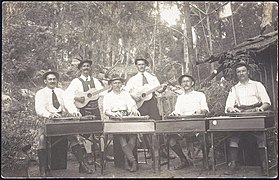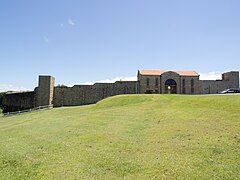Australian internment camps in World War I.
In Australian internment camps during the First World War ( English internment camps or German concentration camps ) mainly prisoners of war and internees of German and Austrian origin were held. At the beginning of the First World War, around 4.5 million people lived in Australia, including around 100,000 Germans. There were also Japanese , Chinese and Turks in the camps. During the First World War, 6,890 Germans were interned in Australia, of whom around 4,500 had already settled.
The British military had experience with the establishment of internment camps, which they could already collect in the Boer War of 1899-1902. When the First World War began in 1914 , the Australian federal government decided to set up internment camps in all Australian states.
Legal regulation
The organization and structure of the detention was based primarily on the British Royal Warrant (German: royal charter ) in August 1914. On October 29, 1914 passed the Australian parliament the War Precautions Act , which gave the military broad powers, not only combatants but also to arrest opponents of the war in Australia. On the basis of this law, the Australian federal government declared people of German and Austrian descent, Japanese, Chinese and Turks to be enemy aliens (German: internal enemies). This also affected Germans who had lived in Australia for generations. The suspicion of disloyalty was sufficient for this. In agreement with the Australians, the British government also transported prisoners of war and enemy aliens from the South Pacific region to the Australian internment camps.
designation
The internment camps in Australia during World War I were commonly referred to as concentration camps . The term concentration camp , which is literally translated into German, reflects an entirely different reality that relates to the criminal regime of the Third Reich (1933–1945), so such a translation is obsolete. In the more recent Australian literature, the term concentration camps is no longer used as a clarifying issue for internment camps. During World War II , Australian internment camps were commonly referred to as internment camps .
Inmates
Initially, when the war began, prisoners of war and internees were housed in military barracks or training camps in Australia. But it soon became clear that special accommodation had to be provided for this purpose and further internment camps had to be set up across the country. Existing prison buildings were preferred. As early as May 1915, around 3,000 German people had been interned. Germany had several colonies in the South Pacific and German ships were still anchored in Australian ports at the beginning of the war. The people on it were interned as enemy aliens . But also prisoners of war as well as mainly German but also Austro-Hungarian people, some of whom had lived in Australia for generations, were held in internment camps. Until the end of the First World War in 1918, Austria-Hungary was a multi-ethnic state that existed from 1867 to 1918 . In this monarchist state structure, German-speaking Austrians lived together with other speakers such as Serbs , Croats , Hungarians , Czechs and Romanians .
Treatment in the camp
For prisoners of war in the state of New South Wales, the Rules for the Custody of and Maintenance of Discipline among Prisoners of War in NSW of August 1914 were applied, which applied not only to internees but also to prisoners of war. It was regulated, two roll calls, the wake-up and bed times and the food.
Likewise, the choice of a camp committee was possible that for the general welfare (German: common good ) of the internees responsible and the camp commandant was opposite report fee. The camp committee could also form sub-committees for, for example, recreation, theater and music events, kitchen matters, educational measures and other aspects.
The treatment of the camp inmates varied, and in general it can be described as liberal. There were three internment camps (Holsworthy, Trial Bay Gaol and Berrima internment camps) where inmates enjoyed a lot of freedom. In other camps there were stricter regulations. For example, there was no fencing in either the Trail Bay Gaol or Berrima camps. In Berrima camps, inmates were not allowed to move further than two miles around the camp. However, they were allowed to build huts outside for their stay and for their leisure activities. However, their freedoms were limited, the post office was checked and they could not go to other camps and visits from relatives were limited in time. The sanitary conditions were, however, primitive.
There were also repeated conflicts with the security guards, who were mostly not properly prepared and qualified for their tasks. An extreme incident occurred in the notorious Torrens Island internment camp in 1915 when two internees who had fled were caught and, on the instructions of the camp commandant, Captain Hawkes, had them punished with whipping and beating in front of the guards and the internees. The incident was investigated and the camp was disbanded shortly thereafter.
Camp life was not comfortable, the camps were sometimes overcrowded and the sanitary facilities inadequate and primitive. There were differences between the ethnic groups and political views in the camp. Heat, cold, fog and boredom, stress and a life without family and without the usual professional life lead to the so-called barbed wire disease (German: barbed disease ). The guards sometimes mocked the inmates and shot them too. Some internees tried to flee or took their own lives. Many were put in prisons in the camp when they behaved unruly.
The entrance to the prison building of the Berrima internment camp
A music band in the Berrima internment camp , dressed in traditional German costumes and musical instruments with four zither and two guitar players (1916)
Prison building on the grounds of the Holsworthy Detention Center , called Sing Sing
The inside of the dining room in the prison or internment camp called Trial Bay Gaol
Wall and gatehouse to Trial Bay Gaol
List of internment camps
In addition to the camps mentioned below, there were also smaller and only temporary internment camps on Bruny Island ( Tasmania ), Garden Island ( Western Australia ) and in Fort Largs ( South Australia ). Most of the camps were in New South Wales and the largest was the Holsworthy internment camp near Sydney .
| Australian internment camps in World War I. | |||||||
|---|---|---|---|---|---|---|---|
| Internment camp | place | State | in operation | closed | Maximum occupancy | Internees by country | |
| Berrima internment camp | Berrima | New South Wales | 1914 | August 1919 | 400 | German internees and marines, including numerous prisoners of the small cruiser Emden , which was defeated by the cruiser Sydney on November 9, 1914 in a battle . | |
| Bourke Internment Camp | Bourke | New South Wales | 1914 | 1918 | unknown | German families who came from Singapore , Malaysia , Ceylon (today Sri Lanka ), Hong Kong and the islands in the South Pacific as well as from the surrounding areas of the camp. | |
| Enoggera internment camp | Gaythome | Queensland | 1914 | August 1915 | 140 | Ship officers and crews of German ships when the war began in the port of Brisbane were | |
| Holsworthy Internment Camp | Holsworthy | New South Wales | 1914 | May 1920 | 6000 | Prisoners of war and German, Austrian, Italian and Japanese internees | |
| Langwarrin Detention Center | Langwarrin | Victoria | 1914 | 1915 | 940 | Germans, Austrians and Turks | |
| Molonglo internment camp | Molonglo | Australian Capital Territory | 1918 | 1919 | The camp was prepared for 5000 German and Austrian families with children from China and East Africa . However, it was only used as a transit camp to the Bourke internment camp. | ||
| Rottnest Island Internment Camp | Rottnest Island | Western Australia | 1914 | 1914 | 1000 | Interned Germans and Austrians and prisoners of war. Many of the interned Austrians came from Slavic ethnic groups. | |
| Torrens Island Detention Center | Torrens Island | South Australia | 1914 | May 1915 | 400 | German interned men | |
| Trail Bay Gaol Detention Center | South West Rocks | New South Wales | 1914 | 1918 | 580 | Military officers and Germans as well as Austrians who had a high social or military status. Some of the naturalized Germans in Australia had lived there for generations. Many of the internees also came from the Pacific , China, and Southeast Asia . | |
Individual evidence
- ↑ a b Internment , on germanaustralia.com. Retrieved September 22, 2017
- ↑ Berrima Internment Group , on environment.nsw.gov.au. Retrieved September 22, 2017
- ^ Beverley Donald: Holsworthy Internment Camp during World War I , on dictionaryofsydney.org. Retrieved September 22, 2017
- ↑ Torrens Island Internment Camp , at sahistoryhub.com.au. Retrieved October 13, 2017
- ↑ Holsworthy Internment Camp , on migrationsheritage.nsw.gov.au. Retrieved September 22, 2017
- ↑ a b c d e f g h World War I Internment Camps , on naa.gov.au. Retrieved September 22, 2017
- ↑ Langwarrin Internment Camp , at migrationheritage.nsw.gov.au.






